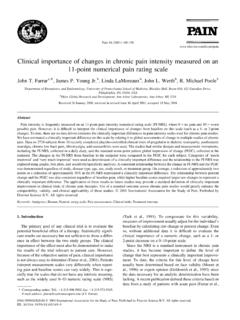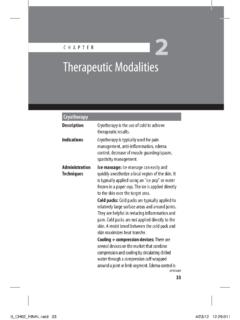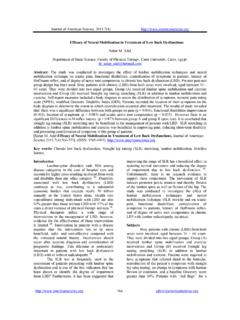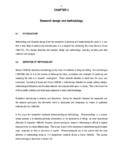Transcription of Clinical Indications and Protocols For …
1 Clinical Indications and Protocols For electrotherapy and ultrasound FORM 4575A 1 Table of Contents electrotherapy ..2 electrotherapy Overview ..2 Clinical Protocols and Rationale ..2 Acute Pain ..2 Chronic Relax Muscle Spasm ..4 Increase Local Circulation ..4 Prevent / Retard Disuse Muscle Range of Motion ..7 electrotherapy Clinical Protocols Summary (Table 1)..8 Basic electrotherapy Waveform Types of Electrotherapeutic Basic Waveform Overview of electrotherapy Waveforms on Chattanooga Group electrotherapy 11 Interferential (IFC) .. 11 Premodulated .. 12 Symmetrical 12 Microcurrent .. 13 Russian.
2 13 High Volt (High Volt Pulsed Current HVPC) .. 14 16 What is ultrasound ? .. 16 Heating Rate 16 Treatment Time 16 Clinical Protocols and Rationale ..17 Sub Chronic / Superficial Muscle .. 17 Sub Chronic / Superficial Tendon and/or Ligament .. 17 Sub Chronic / Deep Muscle, Tendon and/or Ligament .. 17 Chronic / Superficial Chronic / Superficial Tendon and/or 17 Chronic / Deep Muscle, Tendon and/or Ligament .. 18 Scar Tissue or Adhesions / Superficial 18 Scar Tissue or Adhesions / Superficial Tendon and/or Ligament .. 18 Scar Tissue or Adhesions / Deep Muscle, Tendon and/or Ligament ..19 Joint Contracture and/or Adhesive Capsulitis / Superficial Joint Tissue.
3 19 Joint Contracture and/or Adhesive Capsulitis / Deep Joint Tissue ..19 ultrasound Clinical Protocols Summary (Table 2) .. 20 ultrasound 21 22 2005 Encore Medical Corporation or its affiliates, Austin, Texas, USA. Any use of editorial, pictorial,or layout composition of this publication without express written consent from Chattanooga Group of Encore Medical, is strictly prohibited. This publication was written, illustrated, and prepared for distribution by Chattanooga Group of Encore Medical, 2 electrotherapy electrotherapy Overview electrotherapy is the application of electrical stimulation transmitted through the body via electrodes for therapeutic purposes.
4 The current flows through the body from one electrode to the other and causes different physiological reactions depending upon the type of current selected, the parameters of the selected current, and the output intensity. As current flows through the body it can stimulate nerve and/or muscle tissue causing pain relief, muscle contraction to prevent/retard disuse atrophy or re-educate a muscle, relax spasms, or increase local circulation. Clinical Protocols and Rationale Acute Pain Waveform Rationale The main physiologic effects of Interferential and Premodulated current are to depolarize peripheral sensory and motor nerve fibers creating either an inhibitory effect of the pain transmitting cells in the dorsal horn of the spinal cord (theoretical Gate Control Mechanism) or the activation of supraspinal areas containing neurons capable of releasing endogenous (from the body) opiate substances to block pain (theoretical Endogenous Opiate Mechanism).
5 Motor nerve activation will increase local blood circulation and relax muscles in spasm. Electrode Placement Electrode Placement guidelines to successfully manage acute pain with Interferential current are as follows: Clinical exam identifying the patient's area and source of pain. Skin Preparation: Clean and inspect the skin. Follow electrode manufacturer use guidelines. Electrode Placement: The literature describes optimal Electrode Placement having the 4 electrodes precisely around or bracketing the target tissue. Electrode Placement guidelines to successfully manage acute pain with Premodulated current are as follows: Clinical exam identifying the patient's area and source of pain.
6 Skin Preparation: Clean and inspect the skin. Follow electrode manufacturer use guidelines. Electrode Placement: The literature describes optimal Electrode Placement having the 2 electrodes precisely around or bracketing the target tissue. 3 Chronic Pain Waveform Rationale The main physiologic effects of Interferential current are to depolarize peripheral sensory and motor nerve fibers creating either an inhibitory effect of the pain transmitting cells in the dorsal horn of the spinal cord (theoretical Gate Control Mechanism) or the activation of supraspinal areas containing neurons capable of releasing endogenous (from the body) opiate substances to block pain (theoretical Endogenous Opiate Mechanism).
7 Motor nerve activation will increase local blood circulation and relax muscles in spasm. Electrode Placement Electrode Placement guidelines to successfully manage chronic pain with Interferential current are as follows: Clinical exam identifying the patient's area and source of pain. Skin Preparation: Clean and inspect the skin. Follow electrode manufacturer use guidelines. Electrode Placement: The literature describes optimal Electrode Placement having the 4 electrodes precisely around or bracketing the target tissue. Electrode Placement guidelines to successfully manage chronic pain with Premodulated current are as follows: Clinical exam identifying the patient's area and source of pain.
8 Skin Preparation: Clean and inspect the skin. Follow electrode manufacturer use guidelines. Electrode Placement: The literature describes optimal Electrode Placement having the 2 electrodes precisely around or bracketing the target tissue. 4 Relax Muscle Spasm Waveform Rationale The literature reports some of the physiologic effects of High Volt Pulsed Current (HVPC) being relaxing muscles in spasm by inducing fatigue. Amplitude settings can be set to levels of muscle contraction to induce fatigue. Electrode Placement Electrode placement guidelines for relaxing a muscle in spasm with High Volt Pulsed Current are as follows: Clinical exam.
9 Skin Preparation: Clean and inspect the skin. Follow electrode manufacturer use guidelines. The treating electrode (lead wire with red ending) positioned over the muscle in spasm. The return electrode (lead wire with the black ending) positioned close by. Electrode Size: Muscle size dictates electrode size. Increase Local Circulation Waveform Rationale The literature has multiple reports showing High Volt Pulsed current increases local blood circulation to the target tissue. Increasing local blood flow with High Volt Pulsed current is also reported to increase tissue oxygenation to an ischemic area when applied over multiple sessions.
10 The current amplitude should be sufficient to produce a comfortable sensation without a motor response. Electrode Placement Electrode Placement guidelines for Increasing local blood circulation with High Volt Pulsed Current are as follows: Clinical exam. Skin Preparation: Clean and inspect the skin. Follow electrode manufacturer use guidelines. The treating electrode (lead wire with red ending) positioned directly over or immediately adjacent to the target tissue. Electrode size sufficient to cover treated area. The return electrode (lead wire with the black ending) should be the same size of the treating electrode and positioned close by.






